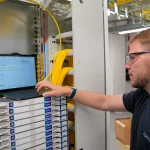BT Sign OneWeb Deal to Tackle UK Rural Broadband Slow Spots

UK ISP BT and satellite operator OneWeb, which is partly owned by the UK government, have reached an agreement that will see the two working together to bring ultrafast low-latency broadband speeds to some of the hardest to reach rural parts of the country, where even their £5bn Project Gigabit programme would struggle to go.
At present OneWeb has launched a total of 218 small Low Earth Orbit (LEO) satellites into space, with another 36 set to join those on 1st July 2021, and the initial plan is to build a constellation of 648 satellites, which is enough for a reasonable level of global coverage by around the end of 2022.
After that they have future approval for a total of 2,000 satellites and 1,280 of those will be a second-generation model that could sit in a higher Medium Earth Orbit (MEO) of 8,500km, but the latter would require much more investment. The first initial commercial (beta) broadband services are due to go live across parts of the UK, Alaska, Canada, Northern Europe, Greenland, Iceland, and the Arctic seas in November 2021.
Advertisement
The new network could potentially deliver ultrafast broadband speeds (100Mbps+) and latency times of under 40ms (example), although we still don’t know what sort of service will actually be made available to the domestic connectivity market and how much it might cost. Nevertheless, if recent tests by the rival Starlink (SpaceX) platform are anything to go by, OneWeb could offer a fix for poor broadband speeds in rural areas.
Back in February 2021 we reported that OneWeb were in early stage talks with telecoms giant BT (here) about the possibility of the two working together in order to tackle some of the hardest to reach parts of the country. The good news today, as confirmed by the Telegraph (paywall), is that an agreement has now been reached.
Philip Jansen, BT Group CEO, said:
“It is clear that greater partnership is needed, both with Government and within industry, to ensure connectivity can reach every last corner of the country. Our agreement with OneWeb is an important step to understanding how that goal could be achieved in the future.”
The deal could provide a solution for ongoing concerns around the 10Mbps Universal Service Obligation (USO), which was originally touted as a fix to help connect some of the remotest areas. However, there are tens of thousands of premises in the final 1% of the UK where even the USO becomes far too expensive (here), with some install quotes even reaching beyond £1m+ for FTTP (i.e. in areas where even 4G can’t reach).
Similarly, even the Government’s new £5bn Project Gigabit programme has warned that it considers the final 0.3% of premises “could be prohibitively expensive to reach” (i.e. the same sort of area as their 10Mbps USO was supposed to fix). A separate consultation is currently considering how to tackle those, which is looking at everything from Fixed Wireless Access (FWA) networks to LEO satellites.
Advertisement
In our view, there are three potential approaches that BT and OneWeb could take with their new deal.
Possible BT OneWeb Broadband Solutions
— Satellite capacity for a 5G mobile or fixed wireless network.
— Satellite capacity to support a local fibre or hybrid fibre network.
— Direct to customer broadband solution (dish on house etc.).
At the time of writing, we haven’t seen any sign of a direct to consumer (Starlink style) broadband solution, although OneWeb has also talked about such a possibility. Nevertheless, most of the time the satellite operator has preferred to talk about domestic connectivity as serving “communities” (i.e. usually a reference to using satellite capacity for a community distribution model, such as to feed a local fixed line or wireless network).
Lest we forget that BT has also helped to develop satellite technologies for use alongside 5G networks (here), which might plausibly be used to kill two birds with one stone (mobile and broadband connectivity) in remote rural areas. Obviously, the Government, which has already invested £400m ($500m) into OneWeb, will be keen to see the two working together in order to help validate their investment. Time will tell.
UPDATE 28th June 2021
Advertisement
A tiny bit more detail on this. The BT and OneWeb deal is based on a Memorandum of Understanding (MoU), which will see the pair work together in order to find ways of solving rural broadband notspots and slowspots. The ideas proposed by this MoU are much the same as the ones we suggested above, but it’s all still very much in the R&D phase.
In our experience it tends to take quite a long time to turn such things into a viable commercial product, so it may be awhile before we see a domestic connectivity solution.
Mark is a professional technology writer, IT consultant and computer engineer from Dorset (England), he also founded ISPreview in 1999 and enjoys analysing the latest telecoms and broadband developments. Find me on X (Twitter), Mastodon, Facebook, BlueSky, Threads.net and Linkedin.
« H1 2021 – Fastest National UK Mobile and Home Broadband ISPs
Cheap BT Home Essentials Social Broadband Tariff Goes Live »






















































Not sure what the performance will be like, but I hope at least it will lead to lower Starlink prices.
With a global reach, I doubt Starlink will much care about what happens in the UK and will just set their prices to what they want regardless.
It’ll be interesting to see the impact of Medium Earth Orbit constellations on latency. It seems like a step backwards.
Perhaps they are aiming for long dwell time? https://en.wikipedia.org/wiki/Molniya_orbit
Would make sense if it is intended specifically to serve the UK, especially for less-latency-sensitive purposes such as phone calls and telemetry.
Latency may not be such an issue if they use a setup that dynamically organises tasks between the most appropriate platform. So a big download could be shifted to MEO, but online video gaming would relay over LEO etc.
From reports about O3b, real world MEO round-trip latency is up to 150ms. This would be fine for bulk data transfers but actually identifying the traffic that is bulk is often going to be tough, at least without signalling from the traffic sources (and some incentive to not just classify everything as important).
A molniya/HEO orbit would have similar but worse problems for interactive use, apogee height (and thus max latency) is similar to GEO, but also it’s variable.
5G would be the best solution. I don’t know what’s stopping them laying fibre to cell towers and equipping them with 5G?
This is a story to keep an eye on though I think. But if it came to just satellite dishes on your home, Starlink has the advantage at present. People who have it say it’s good, it’s easy enough to use, and their ordering process is ridiculously simple. Plus the more people who use the service the cheaper it will become.
“I don’t know what’s stopping them laying fibre to cell towers” – terrain! Good cell site locations aren’t necessarily all that easy to get fibre to. It’s not uncommon to use radio backhaul for cell sites, and there are some already using satellite backhaul (EE use some of Avanti’s GEO – https://www.avantiplc.com/case-studies/extending-ees-4g-network/) switching this to LEO would be quite an improvement for people served by those sites.
5G would be the best solution. I don’t know what’s stopping them laying fibre to cell towers and equipping them with 5G?
Whats wrong with good old microwave, most hill areas have fill in terrestrial TV masts.
This is a story to keep an eye on though I think. But if it came to just satellite dishes on your home, Starlink has the advantage at present. People who have it say it’s good, it’s easy enough to use, and their ordering process is ridiculously simple. Plus the more people who use the service the cheaper it will become.
Will the Starlink success bring eventual congestion, slowing down the service when everybody piles on to it, just like Three?
Will there be enough funds to replenish the satellites when their orbits decay?
Of course we could have had fibre years ago (and to the Cochrane nay sayers, go forth and search, there is more than enough evidence out there, but as usual, Govenment meddling messed it up)
Me, you have both offered solutions, but I’m glad you seem to agree 5G would be best. I’m sure we can come up with a solution for placing 5G masts in rural areas as you suggested even using radio backhaul links.
Trouble is I guarantee people will object to cell towers anyway so planning permission will never be granted.
And absolutely we could have had fibre years ago. But government is good at messing things up and waiting select corporations earn the money from the contracts.
@Me
Actually I didn’t agree re 5g being the best, I tried to change comments to italic/bold to make my response more understandable, but it didnt work so thats why there are blank lines between your comments and mine.
FTTP is the better but more costly/difficult solution, 5G with its various frequencies will present problems, and definitely a decent backhaul will be required for the non local setup.
That said it will provide something better than the current adsl/vdsl pathetic ripoff service.
Re masts, things are becoming easier re height, and planning permissions.
You’ve lost me with your comment here. They do of course run fibre to masts. Most EE transmitters are fed by fibre, and those that aren’t are usually fed by microwave from a nearby fibre fed mast.
What we are talking about here is a solution for areas where it is deemed not economically viable to use a mast.
Yet more pollution in the night sky, space junk everywhere
Agree. Much rather have improved 4G and possiblity of 5G than having a load of space junk.
If you wanted to concentrate on rural locations within the UK alone, why not use HAP’s rather LEOs?
Because they need to be refuelled on a regular basis?
@GNewton: Not if they’re solar powered.
We have to launch 1000’s of satellites because BT are too lazy to run some fibre? Right.
No, Oneweb are launching a bunch of satellites to fulfil a government contract, Openreach/BT will only be signing a contract to make use of the infrastructure.
I think many seem to forget how many issues telecom providers go through try to install infrastructure when communities and land owners restrict progress.
It’s unlikely to be laziness, isn’t it? What a silly comment.
It will be interesting to see how this is pitched.
If it is pitched at the same price as the standard offerings then all well and good.
This then creates budgetary pressure to reduce dependance on it as a solution so FTTP % will continue to rise.
If it is pitched as a more expensive offering then I have real problems with that as it is not a USO but something else.
I agree that you might, as an intermediate step, feed all of a remote village via individual dishes and then progress to a single dish feeding a local FTTP network.
Ultimately you then look to FTTP backhaul but I can see that it might be more of an issue with very remote locations.
The great thing about this is that you get stepping stones of quick fixes towards good long term solutions.
Do you though, there’s been a sum total of zero ‘stepping stones’ in my area since dial up was replaced with adsl. None of the improvements to the network have reached here and I’m of the feeling that once a quick fix was put in place it’d be a very long time before any further effort was made.